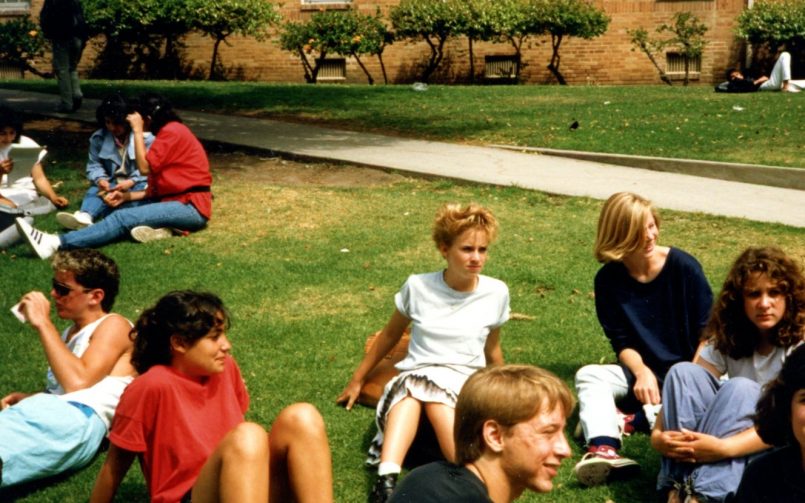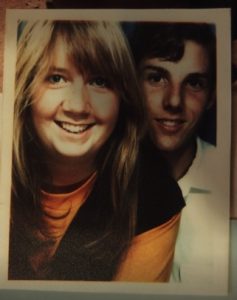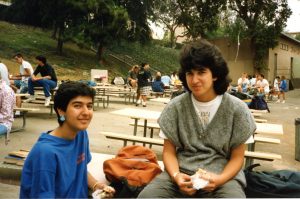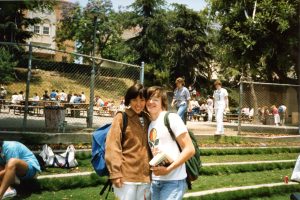
31
Jan, 2019
Don’t You Forget About Us…or The Value of Public Education: Class of ‘86
A couple of things happened over the Winter break. One, it was announced that the teachers in LAUSD would probably be going on strike, and, two, my friend Kimberly Steinman, Class of ’86, posted some pictures of our days at Uni on Facebook. My eye was drawn to the pictures where I saw myself or my friends, people I had known since Emerson –and some I even remember from Westwood Elementary.
I imagined Uni as a giant aquarium, with all of us fish swimming around it. If the aquarist were to plunge his net down into it, and pull some of us out, what would he find? What had we all become? And for me, as an educator and a champion of public education, what impact had the offspring of our Uni ecosystem had on the larger environment? So I thought I would find out what a few of my fellow Warriors from the Class of ’86 have accomplished. What follows is just a tiny fraction of what our hard work, our commitment to society, and our public education yielded from our class alone. So here are a few of the stories to go with the pictures. While some people pictured are not named, I only wrote about people from whom I could obtain permission.
I have some rudimentary understanding of what Dr. Kim Steinmann (pictured above) is doing today professionally. When she’s not gardening, beekeeping, creating the most beautiful garden/insect-related stained glass windows, or taking exquisite photos of either one, she is working hard to keep the rest of us safe overseeing Pesticide Use Reporting (PUR) database. This PUR data is used in a variety of programs related to environmental monitoring, human health assessment, protecting worker health and safety, pesticide risk mitigation, pesticide use enforcement, focusing outreach efforts, promoting research, and fostering reduced risk pest management at the California Department of Pesticide Regulation. After all of this, she donates some of her spare time into talking me down from my “we’re all being poisoned” ledge. There are folks watching out for our health and safety, and I am grateful she’s one of them.
In the picture at the top of this post, I recognize Dalia Dassa, now Dr. Dalia Dassa Kaye, sitting in red. I remember her as a highly intelligent, even-tempered young woman –the exact type of person people would want to have in their nation’s corner weighing in on Middle East policy, which is just what she is doing today. In her current position, Director, Center for Middle East Public Policy; Senior Political Scientist at Rand Corporation, she focuses on arms proliferation and control, international diplomacy, Iran, Israel, Middle East, and the Persian Gulf Region. As a respected and influential voice shaping the narrative around global security, she has written countless commentaries and made appearances on many shows, where she applies thoughtful and pragmatic analyses regarding our role in the region. You can read more about these contributions to the Middle East dialogue, and her impressive biography on the Rand site can be accessed online.
Just a foot to the right of Dalia, sits Dr. Kerstin Wasson. While Dalia works to resolve global conflicts, Kerstin has been called “a secret weapon” by the National Estuarine Research Reserve Association when they reported that she had won the Environmental Law Institute’s Science Research Award at the 2018 National Wetlands Awards in May. They summarized both her work and her spirit here, “If you’ve been around the NERRS long enough, you know that when Dr. Kerstin Wasson puts her energy behind an idea, something good will happen. Since she joined the Elkhorn Slough Reserve 18 years ago, she has been like a force of nature as she advances wetland science, engages citizens as partners, champions wetland restoration, and leads System-wide initiatives that focus the collective power of Reserve research on critical national problems.” A committed researcher and advocate for our estuarine ecosystems, Kerstin is actively involved in research to promote and protect our coastal environment. You can read about her online, and her research lab website is here.
To the right of Kerstin is Kathryn Wright. In the summer of 1985, Kathryn and I were at the latest Brat Pack movie, talking before the show started. A man with long hair and a beard, unusual in 1980’s LA, was eavesdropping on our conversation from the row ahead. He was so impressed with Kathryn’s insightful banter on music that he turned around, handed her his card, and told her to call him. The name on the card: Rick Rubin, the now legendary record producer. She never did call, but today she is using her vast musical knowledge as Managing Director of the US-China Music Institute of the Bard College Conservatory of Music. Established in 2017, the program has the mission of promoting the study, performance, and appreciation of music from contemporary China. The program aims to foster goodwill between the U.S. and China through an undergraduate degree program in Chinese instruments, an annual music festival, and seminars and conferences on Chinese music, art, and social development. It is no surprise that Kathryn’s interest in culture and music has become part of a global endeavor in cultural exchange and transnational amity.
I sit next to Kathryn. I have been a teacher of both children and adults for over twenty-five years. Now I am teaching one English class at Uni High, running the library, and trying to maintain the alumni newsletter and blog because the alumni have done so much to support our students and the library. I have taught all over Los Angeles, a city where some of the harshest realities of global conflicts, conquests, and homegrown policy converge in our schools.
In front, of me is the blond guy, Clay, who sat behind me in 9th grade English at Emerson. I do remember he had these interesting and genuine observations about people’s behavior, and I can see the link between that teenager and the researcher he is today. Dr. Clay Holroyd earned his Ph.D. in neuroscience in 2001, and currently works at the University of Victoria on research that has the potential to help people with a host of neurocognitive disorders including Parkinson’s disease, attention-deficit hyperactivity disorder (ADHD) and depression. He and his research partners have been focusing on the role the midcingulate cortex in brain dysfunction. We are lucky to have alumnus, Clay Holroyd, doing this important work as the benefits could touch all of us in the future. You can learn more about his work here.
Above is Dr. Nielufar (Nelly) Varjavand sitting to the left in the grove, enjoying her lunch with a friend. I remember her as an extremely kind, encouraging friend, the kind of person you would want in your corner. Thus, it is not surprising that she occupies various support roles as a professor and physician at Drexel Universityand The Drexel Center for Women’s Health.Her clinical focus includes preventive and general primary care as well as women’s health. Dr. Varjavand works bringing physicians up to speed who are re-entering the profession after years of working in other fields or dealing with their own health issues. Programs like this bring doctors whose expertise and experience are needed back into the profession, benefitting countless patients. She has also done work to help resident doctors become more adept at interviewing patients to detect whether or not domestic violence is a cause or contributing factor in patients’ health issues. This saves money and lives as doctors trained in detecting domestic violence are less likely to order unneeded tests or squander valuable time with false diagnoses and more likely refer patients to the services that will help them physically and psychologically.
Also at Drexel University, she started a program in 2014 dedicated to the field of global health that teaches the basic core competencies of global health. The site states, “Drexel University College of Medicine supports your pursuit of compassionate care and safe global health learning. We believe that medical education should include learning about one’s own community and the global community.” It is worth checking out -particularly if you know a young person interested in pursuing medicine and having a global impact. The support she has provided to the worldwide medical community and to patients is incalculable.
You may remember Jeremy Martin (above) from his cross-country days at Uni. He hasn’t run out of steam yet. He still moves fast, as an avid cycler these days, which not only feeds his athleticism but also his mission to solve our most important environmental crisis. Dr. Martin has a Ph.D. in chemistry and a minor in chemical engineering from Caltech. In undergrad at Haverford he majored in both chemistry and English. Given that, I will not attempt to re-write his bio for him, as I am sure he can do it better than me. It reads as follows:
“You can read this and more on the Union for Concerned Scientists website:
As a Senior Scientist in the Union of Concerned Scientists’ Clean Vehicles Program, Jeremy Martin evaluates the impact of biofuels and fuel policy. Dr. Martin is the author of more than 15 technical publications and 13 patents on topics ranging from biofuels lifecycle accounting to semiconductor manufacturing and polymer physics. His recent report for UCS, Fueling a Clean Transportation Future: Smart fuel choices for a warming world describes how transportation fuels are changing, and what can be done to reduce emissions from their production. Dr. Martin has testified before Congress and briefed state and federal legislators and regulators on key fuel policies. He has served on several expert panels examining how the fuels industry is changing, and what can be done to move it in a cleaner direction.”
I hope that Jeremy will not only be part of our past, but part of a future where our top minds have an opportunity to succeed in addressing climate change and the need for clean energy.
Next to Jeremy is Amy Muraki, who like me is a teacher. I got in touch with her to ask her permission to use this photo. Truth be told, we are both wondering what do we say as stand among these highly accomplished people as humble schoolteachers. So I will say this for her and for me and for all the teachers who made it possible for the aforementioned people to thrive:
After teaching kindergarten for ten years, where she no doubt used her intelligence, artistic, and musical talents to help hundreds of little folks, she began teaching special education at the high school level in Watsonville. Amy doesn’t have to tell me what she does because I remember Amy, and I have intimate knowledge of what it means to be in this intimate profession. She is all heart when heart is the only thing that is needed, but she provides structure to the kids who feel amorphous in a world where it seems all their peers are marching ahead in prescribed form. She knows when to be humorous and vivacious, and when to appear opaque and untouchable. She knows how to awaken those who have long-since checked out and how to sooth the angriest who are inching toward explosion. She understands trauma and how to help heal it, and she understands innocence and how to preserve it. She loves and believes in kids who might not believe in themselves. She loves and believes in kids who love nothing better than themselves. She will learn how to morph from the beautiful young teacher who is the light in the room to the one who is there to witness the brightest shine of the youths today. Whatever it takes to get through to kids, she will find it within herself. And if she comes up empty, she will search it out and have it at the ready for the next kid who needs it.
It’s what our teachers did. Our public school teachers. A good many of them gave their best to us and we took it, often without much of a second thought, as it should be. I know that Amy is one of the ones for whom teaching is about love and art, about waking up hoping that it’s not an easy day…because by this stage of the game, whatever the next big challenge is, she’s got this one.
The students of today are no less than we were. In fact, they are more. It’s the way of humanity: we pass down learning and improve upon it in the next generation. The greatest scholars among today’s students absolutely exceed the level of work we produced. They have three decades of knowledge to draw upon that we didn’t have. Class discussions are more open and encompass more global perspectives as well. Lesbian, gay, and transgender students of today are not just accepted, but they are celebrated and visible. Uni is now a school serving many more low income students than it once did, so we do face different challenges. Proposition Thirteen has proved to be the gift that keeps on taking from the public schools, as we face many other existential threats as education policy visits change on us all. But we stand strong, and we do so in part because of the support we have received from alumni who graduated many decades ago. I hope as we age and see our children graduate from college that we will be able to continue this tradition of support because what we have is well worth saving. I am comparing it to the best of times, and it still shines bright.


